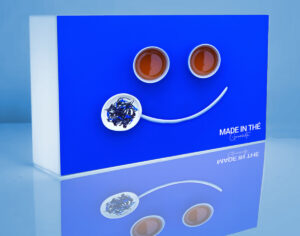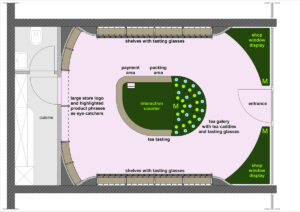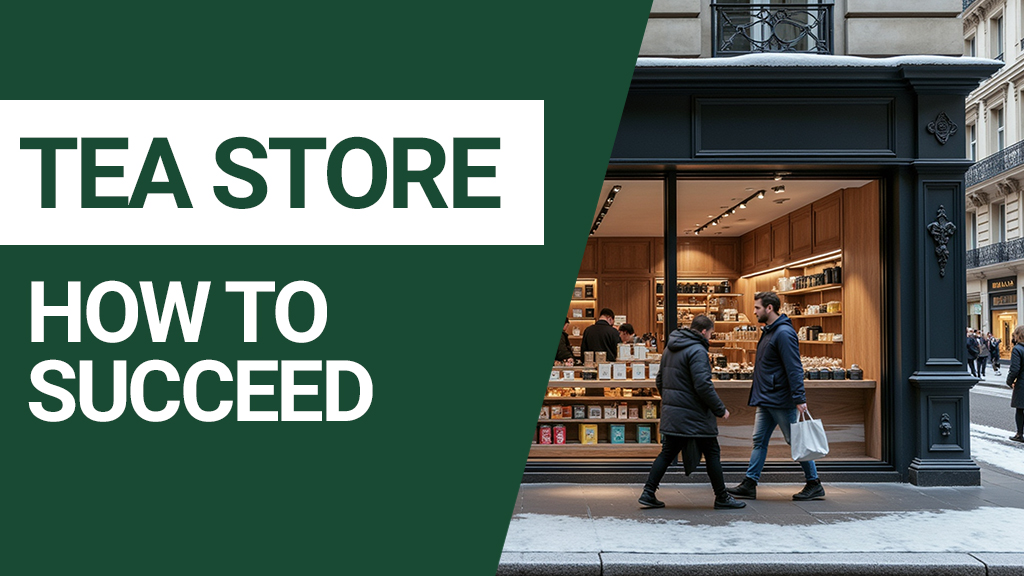Are you opening your own tea shop or looking for a bright idea for a successful revamp?
Here are my 10 tips for a perfect tea shop concept and design.
We will go through:
- Strategic considerations to find the right location for your tea store,
- How to gain visibility and stand out,
- The importance of a good and fresh design,
- How a modern approach can pay off,
- How to welcome customers,
- How to serve customers faster without compromising service quality,
- And your store’s profitability.
So grab a cup of tea and let’s jump in!
Table of Contents
ToggleHow much sales and profitability can you expect from your tea store?
Do you know how much turnover you can expect in your town? And how much will you earn?
Understanding store finances is 75% of your future success.
That’s why we’ve written a comprehensive article explaining how the average store in France performs:
- How it generates €190,000 in sales before tax per year,
- Why loose tea only accounts for 65% of sales,
- How the owner/manager makes €24,100 net per year…
You’ll find out all about it in this article.
The formula for your business: good location = strategic location + profitable location.
You’ve heard the 3 basic rules of real estate: “Location, location, location”.
That’s true. But to be even more so, you’d have to say: Good location = strategic location + profitable location.
The key is to be in an area highly frequented by a population with purchasing power interested in this type of product.
The atmosphere of the neighborhood and the people who frequent it play a major role.
You must choose a high-traffic area. This is defined by:
- Shopping streets,
- Surrounded by busy, brand-name flagship stores,
- Tourist attractions (e.g. museums),
- Delicatessens, chocolate shops,
- Gastronomic and gourmet halls,
- Entertainment venues and restaurants…
Just as important: what is the street configuration?
- A pedestrian street is great,
- But a street with very narrow sidewalks is generally to be avoided,
- Avoid a street saturated with competition (although a little competition can be beneficial),
- Finally, avoid a neighborhood where a night scene could give you a headache every morning.
Your customers are looking for quality teas that can’t be found in supermarkets. What else do they consume? If you place yourself close to those other places where they go and consume, you’ll have a better chance of capturing their attention and making sales.
And last: The map is not the territory. Visit your area.
Once you’ve shortlisted a few locations, visit them at different times of the day. What seems charming on Tuesday morning might be flat dead on a Saturday afternoon!
And a tea store on a street with no Saturday traffic is a guaranteed disaster.
Search ads and make appointments.
In this order:
- Visit real-estate online portals. It will give you an idea of both rent and popularity for each area,
- Select the premises you want to visit. Don’t be put off by supposedly too expensive areas – sometimes bargains are possible!
- Be imaginative and open to the “slightly different” – something extraordinary can come out.
If your concept is aimed at an international clientele (tourists), proximity to tourist attractions and event centers such as concert halls, opera houses, and casinos can be an asset.
On principle, it’s better to make a few too many appointments than too few. You’ll get a better idea of the property’s potential. You’ll also be able to gather important information about the area’s frequentation from its current tenants.
Once you’ve found the ideal location, negotiate the rental terms. If renovation costs are involved, landlords may be prepared to offer a few months’ rent free, or to contribute to certain expenses.
Everything is negotiated in real estate.
Even options rights and key money.
Receive maximum attention from passers-by
How do you make your store visible from the outside?
Having a store is good. Attracting the attention of passers-by and getting them to come in is better.
You can use shiny, flashing, noisy (!?) elements, … It all depends on your concept, of course. But one thing is clear: stand out.
You can opt for a variety of signs, displays, and lights:
- Illuminated signs with your logo,
- Facade signs with your lettering,
- LED-lit stretch frames with photo prints. Here you will find examples and suppliers of textile stretcher frames,
- Illuminated highlights in the shop window,
- Light-installations on back walls to allow a look deep inside your shop,
- Shop displays showing videos and promotional images,
- Customer stoppers with images placed in the paths of walk-in customers,
- And yes, even customized planters with your logo.
The important thing is to catch the eye and arouse curiosity, so that someone comes into your store. Nothing else.

Some installations may require regulatory approval.
Check before installing if you need authorization for:
- Traffic signs,
- Facade signs and lettering,
- Illuminated signs facing streets and sidewalks.
If you hire professionals to design your store, they can obtain permits for you.
Develop your own unique style!
It’s essential to have a recognizable style, a cachet, a personality.
Where do you get your inspiration? Of course, avoid imitating your immediate competitors. But it’s a good idea to draw inspiration from concepts that work in other locations. Or even concepts that work in other sectors.
The important thing is to refine your style while keeping the customer in mind. It’s all very well if you love your concept, but it has to appeal to him/her – the consumer.
To develop a concept, you can start by playing on a few classic oppositions. Do you want to be:
- Traditional and conservative or original and trendy?
- Minimalist vs. exuberant?
- Luxury vs. affordable?
- Cozy vs. industrial?
There’s no right answer. The aim is to find a formula that appeals to enough customers to build a thriving business.
A few tips from me:
- Dedication and attention to detail are noticed and appreciated by customers. Even if they don’t say so,
- Any concept can work, but be careful not to get too “old-fashioned”. Tea drinkers are younger than they used to be. A Grand-ma-style might not work,
- Look at what other brand designers are doing abroad. Personally, I appreciate the creativity to be found in the United States, Australia, South Korea and Japan.
Redefine the way your teas and herbal teas are displayed.
Example: Will you be packing loose tea in front of the customer? Or will you sell pre-packed doypacks in the back room?
There was a time when every self-respecting store opted for the former. Big boxes by the kilo were stacked on shelves. This shelf was inaccessible to the consumer, as it was placed behind the sales counter.
To smell (not taste), you had to ask the sales assistant to fetch the huge cans one-by-one.
But the days of the classic sales counter are being called into question. And rightly so.
What’s the “modern” alternative?
Essentially, these are pre-packaged, ready-to-sell products. This frees the sales assistant from the act of individually packaging loose tea for each customer.
Modern counters are interaction areas in the middle of the store:
- See: Each loose tea is visible to all, without having to ask the sales assistant for permission,
- Smell: Customers can smell the product for themselves. For example, by placing an olfactory glass or a presentation box with a sample of the tea in open access,
- Taste: Have a continuous tasting area featuring the tea of the day, for example. Customers who taste are those closest to the act of buying,
- Interact: The salesperson, freed from packaging, can talk and advise customers more before the act of buying,
- Sell: I’ve tried it myself, and I can tell you: it works.
A modern tea store can then place the interaction counter in the center of the store. This is much more open and inviting.
Breaking with the classic model is a brave move. But it’s a way of standing out and – for me – putting customer interaction at the heart of the project.
It’s also a way of standing out from the more “old-school” competition…

Other advantages of pre-packaged teas
You’ll be continually confronted with 2 extremes: an empty store on certain days (or at certain times), and a flood of customers at other times.
Imagine yourself at Christmas time. You have 7 customers in front of you, waiting to be served, advised and bought. You have to weigh, wrap and lovingly seal each package.
One thing’s for sure: some of your customers will have the patience to wait. But I don’t bet you’ll make a sale on all of them. Some will leave frustrated. And I don’t blame them.
The solution? Pre-pack.
Pre-packed means ready-to-sell and easy to handle. But it also saves time in the store and means you can serve more customers at once.
When your store is empty, it’s the perfect opportunity to prepare 10 packs of Earl Grey in 100 grams.
And when your store is full to bursting, you can cash in your customers faster or spend more time on advice.
You can serve more customers because you can better manage the timing of your packaging.
But there are other advantages too:
- One is psychological: having a package already sealed conveys the idea that the tea is fresher and more protected. This works for both doypacks and tins.
- The other is qualitative: It allows you to offer more complex packaging that you wouldn’t have time to prepare at the last minute. Like gift-wrapping for the Christmas season. Gift boxes with ribbons can also look great.
And how do you showcase tea in the store window?
I admit, some shop windows are an eyesore.
Many owners confuse their window display with their catalog. They mercilessly overload it with their entire range. It’s discouraging and counter-productive.
A window display is a visual delight. You need to showcase few products, just enough to stimulate curiosity and entice a passer-by to enter your store.
Put another way, the window is there to trigger the act of entering the store, not to sell.
Also, lighting concepts are very important and often overlooked. And I get it, not many of us took a lighting class in high school.
Well-lit shop windows attract attention and interest (even at night). It’s often the first contact with the customer.
Good lighting makes your customers feel much more at ease.
A tip from my own experience: If you have solar control glazing, leave the lights on during the day.
Customers like to see activity inside the store. An empty or inanimate store creates more resistance before entering the store.
Believe it or not, wearing light-colored clothing is also beneficial in this respect.
Managing space: Customers are highly welcome!
One rule: Give it space.
You don’t want your entrance to feel like a maze or fortress.
On the contrary, a spacious entrance is inviting. It creates an open, relaxed atmosphere, inviting customers to explore your business.
Other considerations: Keep the doors open if the weather permits, install an occasional outdoor tea bar…
And don’t forget to celebrate certain events with dignity and pomp. These are good “excuses” to pull out all the stops.
For example, the week of your store’s official opening. In addition to advertising in local newspapers, decorate the storefront and entrance with balloons and a sign announcing the opening. Think gift samples, etc. There’s lots to try out, and the only limit is your creativity.
My final tips for a successful design.
You got it, my advice is to stand out from the competition.
The design of your store should convey the idea of a business that is both unique and authentic. This authenticity is brought to life by you, the owner.
As soon as people start posting photos of your store on social media, it’s a sign that you’re doing a good job.
Your photos and those shared by your customers add considerably to your credibility over time – this added value is a marketing asset for you that shouldn’t be overlooked.
Of course, tea is a matter of taste. But keeping your store clean and presenting fresh samples is essential. Put another way, it’s the first impression that counts.
Your sign, your boxes, your logo… all represent you. So take care of their design.
But don’t forget functionality. A beautiful design for a box is useless if using it is too cumbersome.
Building a small shop can be a solo challenge. For larger projects, it’s advisable to call on an architect and a designer with experience in shopfitting and, more importantly, excellent product design skills (for the designer).
Finally, if you’re on a tight budget for furniture and fittings:
- Save money by buying basic furniture (e.g. shelves from I**A) and customize them to make them “less ordinary”,
- Focus your budget on a few key elements like the countertop,
- Use olfactory glasses so that customers can smell the dried tea leaves for themselves,
- Paint selected walls to highlight a specific area of the store,
- Use printed aluminum dibond sheets to personalize the store. The result can be very professional for a modest investment.
Start your own tea store: It’s now your turn!
As you’ve seen, success in the tea business is a question of strategy, location and customer experience.
A well-located store, an original concept and effective showcasing of your products can make all the difference.
Think about capturing the attention of passers-by, optimizing the design of your store and making purchasing easier with pre-packaged teas.
The goal? Offer a unique experience that builds customer loyalty and boosts sales. Now your turn. Good luck!




